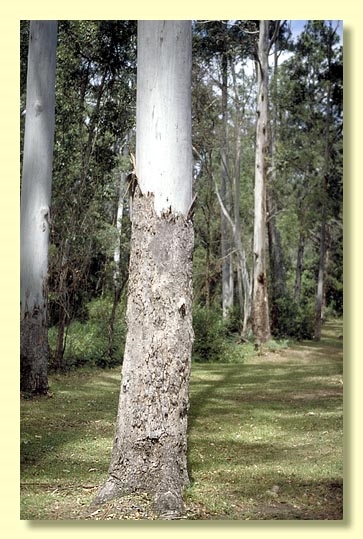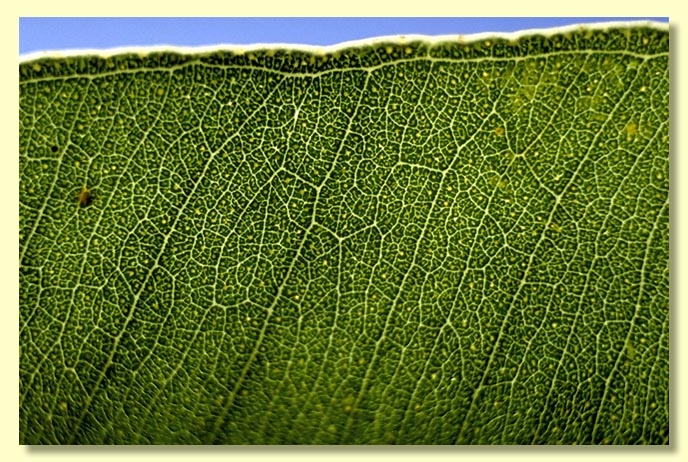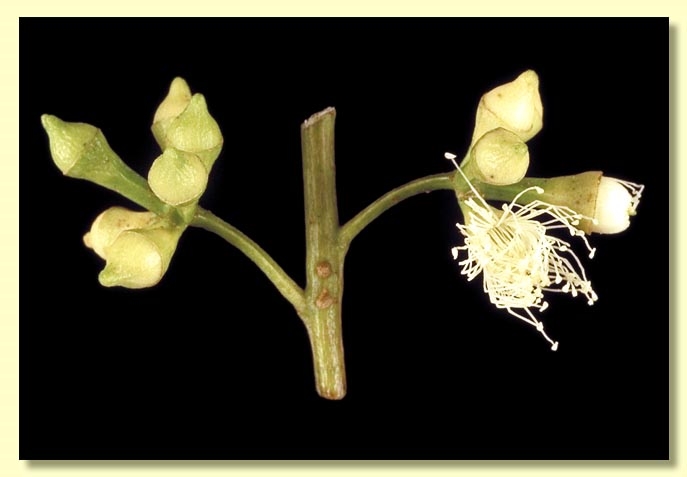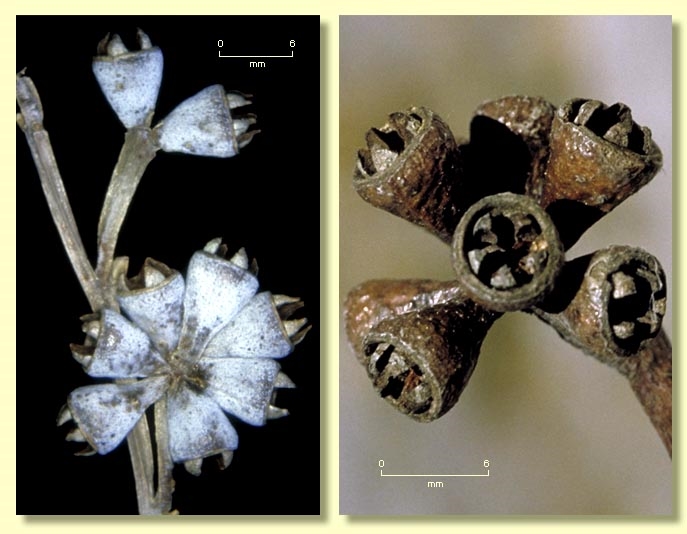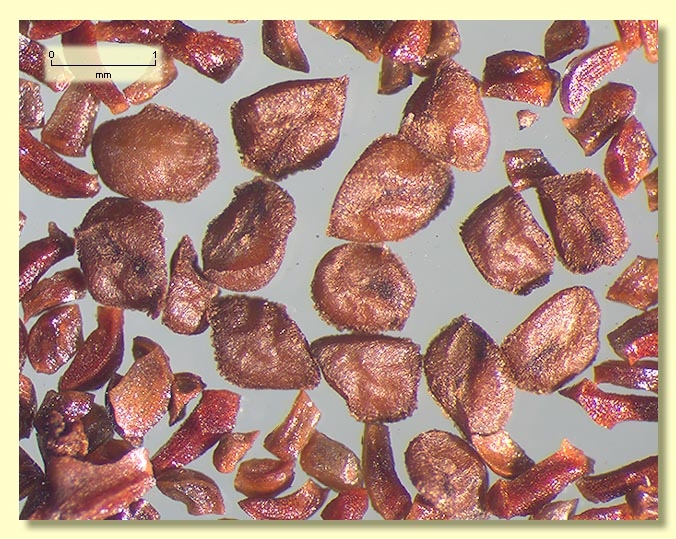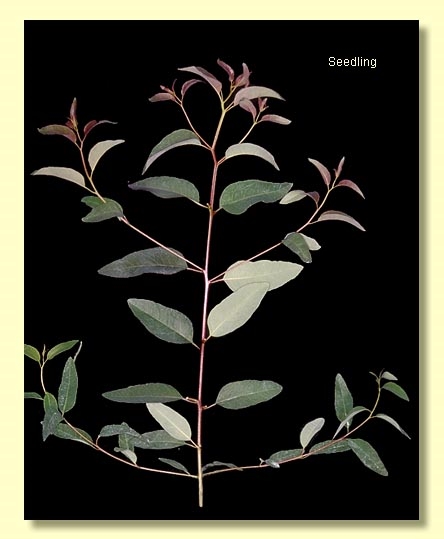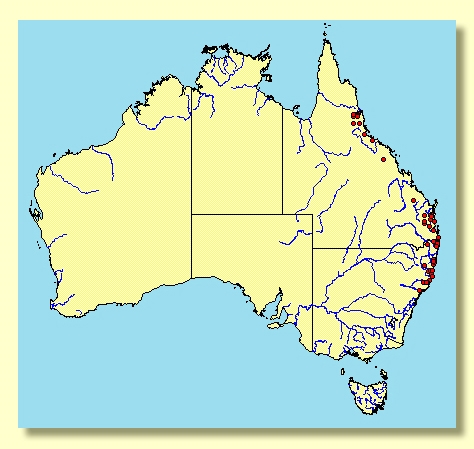Euclid - Online edition
Eucalyptus grandis
Eucalyptus | Symphyomyrtus | Latoangulatae | Transversae
Eucalyptus grandis W.Hill in Anonymous (1862), Specimens of woods indigenous to Queensland. Catalogue of the Natural and Industrial Products of Queensland: page 25.
T: Queensland [near brisbane], W.Hill 74 undated: holo: K. "inhabiting the rich alluvial flats upon the banks of the rivers, and in such has a pillar like trunk, clear of branches for three-fourths of its entire height. The timber is of high repute for its strength, lightness (floats on water when dry) and durability and can be had in great quantities" (fide Bean (2002)).
Tree to 55 (–75) m tall. Lignotuber absent.
Bark rough, flaky, greyish on basal 1–4 m of trunk, smooth above, powdery, pale grey or white.
Branchlets glaucous or non-glaucous.
Juvenile growth (coppice or field seedlings to 50 cm): stem square or rounded in cross-section; juvenile leaves always petiolate, opposite for few pairs then alternate, ovate, 4–14 cm long, 2–8.5 cm wide, base rounded or tapering to petiole, strongly discolorous, darker green above.
Adult leaves alternate, petiole 1–2.5 cm long; blade lanceolate, 8–18 cm long, 1.5–4 cm wide, base tapering to petiole, discolorous, glossy, darker green above and paler below, strongly penniveined, densely to very densely reticulate, intramarginal vein parallel to and just within margin, oil glands island and intersectional.
Inflorescence axillary unbranched, peduncles 1–1.8 cm long, buds 7, 9 or 11 per umbel, sessile or pedicellate (pedicels 0–0.5 cm long). Mature buds ovoid to pyriform to clavate (0.6–0.9 cm long, 0.4–0.5 cm wide), green to yellow or sometimes glaucous, scar present, operculum conical to beaked, stamens irregularly flexed, anthers cuboid or reniform to cordate, versatile, slits separate, style long, stigma blunt, locules 4 or 5 each with 4 vertical ovule rows. Flowers white.
Fruit sessile or pedicellate (pedicels 0–0.7 cm long), obconical, 0.4–1 cm long, 0.5–0.8 cm wide, sometimes glaucous, disc descending, valves 4 or 5, exserted or at rim level, incurved.
Seeds brown or yellow, 1–1.7 mm long, or ovoid or depressed-ovoid, often pointed at one end, dorsal surface usually pitted, hilum ventral.
Cultivated seedlings (measured at ca node 10): cotyledons bilobed; stems square in cross-section; leaves always petiolate, opposite for 3 to 5 nodes, ovate, 4.5–7 cm long, 2.5–4 cm wide, base tapering, margin entire, apex pointed, dull, discolorous, slightly darker green above.
Flowering has been recorded in February, March, April, July and August.
Eucalyptus grandis has been widely used in the timber industry for general construction, joinery, plywood, panelling, boat building and flooring. It is also used by apiarist for the production of honey. It has been planted as an ornamental but is restricted in this area by its ultimate large size.
A tall tree of coastal and subcoastal wet forests of eastern Australia, sporadically distributed from near Newcastle in New South Wales north to the Atherton and Windsor Tablelands in northern Queensland. The bark of Eucalyptus grandis is usually rough at the base, otherwise very clean and smooth, adult leaves are discolorous being darker green above and paler below, usually glaucous buds and fruit and fruit with characteristic incurved valves when dehisced.
E. grandis may be confused with the related E. saligna, a wet forest species occurring from Batemans Bay in New South Wales as far north as Blackdown Tableland in Queensland. E. saligna differs by the development of lignotubers, non-glaucous buds, and fruit consistently with 4 valves that are erect, not incurved, when dehisced. Another species of eastern forests with discolorous leaves is E. deanei, which is distinguished by the completely smooth bark, persistent development of orbicular juvenile leaves in the lower crown and distinctly pedicellate buds and fruit.
Eucalyptus grandis belongs in Eucalyptus subgenus Symphyomyrtus section Latoangulatae because cotyledons are bilobed, leaves are discolorous and have side-veins at a wide angle to the midrib, buds have two opercula and fruit have exserted valves. Within this section, E. grandis is one of three species forming series Transversae because ovules are in four rows, seeds are ovoid and bark is predominantly smooth (a short rough stocking). The other two species are E. deanei and E. saligna which differ as outlined above.


